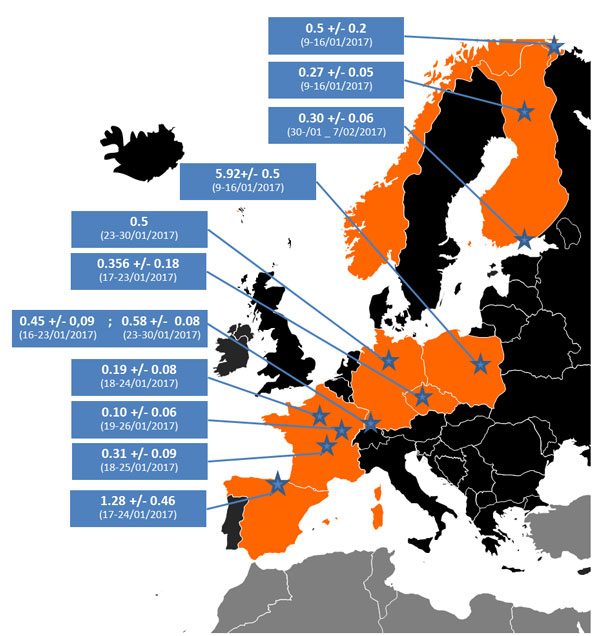U.S. Air Force deploys WC-135 nuclear sniffer aircraft to UK as spike of radioactive Iodine levels is detected in Europe
The USAF WC-135C Constant Phoenix might be investigating a spike in radioactive levels in Norway. Someone speculates the release of this radionuclide could be the effect of a Russian nuclear test.
On Feb. 17, 2017, U.S. Air Force WC-135C Constant Phoenix Nuclear explosion “sniffer,” serial number 62-3582, using radio callsign “Cobra 55” deployed to RAF Mildenhall, UK.
As we have already reported the WC-135 is a derivative of the Boeing C-135 transport and support plane. Two of these aircraft are in service today out of the ten examples operated since 1963. The aircraft are flown by flight crews from the 45th Reconnaissance Squadron from Offutt Air Force Base while mission crews are staffed by Detachment 1 from the Air Force Technical Applications Center.
The WC-135, known as the “sniffer” or “weather bird” by its crews, can carry up to 33 personnel. However, crew compliments are kept to a minimum during mission flights in order to lessen levels of radioactive exposure.
Effluent gasses are gathered by two scoops on the sides of the fuselage, which in turn trap fallout particles on filters. The mission crews have the ability to analyze the fallout residue in real-time, helping to confirm the presence of nuclear fallout and possibly determine the characteristics of the warhead involved: that’s why the aircraft is important to confirm the type of explosion of today’s test.
Along with monitoring nuke testing, the WC-135 is used to track radioactive activity as happened after the Chernobyl nuclear plant disaster in the Soviet Union in 1986 and Fukushima incident back in 2011.
One of these aircraft was deployed near North Korea in anticipation of Kim Jong Un rocket launches then was spotted transiting the UK airspace in August 2013 raising speculations it was used in Syria thanks to the ability to detect chemical substances down wind from the attack area days, or weeks after they were dispersed.
Although they cross the European airspace every now and then, their deployment in the Old Continent is somehow rare. As of yet, there has been no official statement from the U.S. military about the reasons why such nuclear research aircraft was deployed there. However, many sources suggest the aircraft was tasked with investigating the spike in Iodine levels detected in northern Europe since the beginning of January.
Iodine-131 (131I), a radionuclide of anthropogenic origin, has recently been detected in tiny amounts in the ground-level atmosphere in Europe. The preliminary report states it was first found during week 2 of January 2017 in northern Norway. Iodine-131 was also detected in Finland, Poland, Czech Republic, Germany, France and Spain, until the end of January.
However, no one seems to know the reason behind the released Iodine-131. Along with nuclear power plants, the isotope is also widely used in medicine and its presence in the air could be the effect of several different incidents.
Or, as someone speculates, it could have been the side effect of a test of a new nuclear warhead in Russia: an unlikely (considered the ability to detect nuke tests through satellites and seismic detectors) violation of Nuclear Test Ban Treaty.
Maybe the WC-135 will help authorities find out the origin of the Iodine-131.
Detection of radioactive iodine at trace levels in Europe in January 2017
Iodine-131 (131I), a radionuclide of anthropogenic origin, has recently been detected in tiny amounts in the ground-level atmosphere in Europe. The preliminary report states it was first found during week 2 of January 2017 in northern Norway. Iodine-131 was also detected in Finland, Poland, Czech Republic, Germany, France and Spain, until the end of January.
Iodine-131 is a radionuclide with a short half-life (T1/2 = 8.04 day). The detection of this radionuclide is proof of a rather recent release.
Besides the iodine release, the origin of which is still unknown, the poor dispersion conditions due to the thermal stratification [1] of the atmosphere also affected the observed concentration levels, including those of naturally occurring radionuclides such as Lead-210 (210Pb) [2], or fine particles (PM2.5 and PM10) leading to pollution episodes, particularly in the Western part of Europe during week 4 of January.
It must be pointed out that only particulate iodine was reported. When detectable, gaseous iodine is usually dominant and can be estimated to be 3 to 5 times higher than the fraction of particulate iodine.
In France, particulate 131I reached 0.31 µBq/m3 and thus the total (gaseous + particulate fractions) can be estimated at about 1.5 µBq/m3. These levels raise no health concerns.
The data has been shared between members of an informal European network called Ring of Five gathering organizations involved in the radiological surveillance of the atmosphere. In France, IRSN is responsible for monitoring the radioactivity of the atmosphere on a nation-wide scale. Its surveillance network OPERA-Air includes high-volume aerosol samplers (700 to 900 m3 of air per hour) and measurement equipment capable of detecting trace amounts of radioactivity.
Particulate Iodine-131 (value +/- uncertainty) in the atmosphere(µBq/m3) :
More information about the Ring of Five (Ro5) network
Notes:
1- Thermal stratification of the atmosphere that often affects the lower atmospheric layers in winter. The colder air at ground-level compare with altitude stuck or considerably limit atmospheric pollutant dispersion.
2- The 210Pb concentration detected by IRSN peaked at 1600 µBq/m3 in January, four times higher than the usual mean value.




